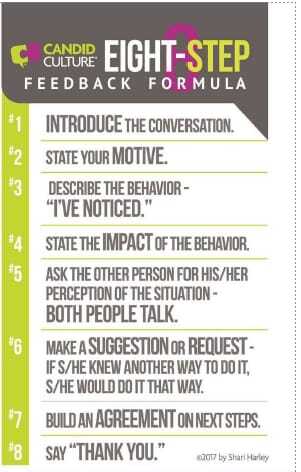- Majid's Newsletter
- Posts
- Forget the "Feedback Sandwich"
Forget the "Feedback Sandwich"
Use this 8-step script for conversations that actually work.

We've all been there. A colleague's habit is derailing your focus. A direct report is under-performing on a key task. You know you need to say something, but the thought of the conversation fills you with dread. What if they get defensive? What if you make things awkward?
So, we often fall back on one of two failed methods: we either say nothing and let resentment build, or we make the cardinal mistake of "calling them out" in public
Before the How, Master the What: Feedback vs. a “Callout”
Before we get to the step-by-step formula, let's clarify a crucial distinction.
Giving feedback to an individual in a team meeting when they didn't meet your expectations is not feedback. It’s a “callout.”
A callout is public, shaming, and triggers an immediate defensive reaction. You may think you're being efficient, but you've just humiliated someone and lost their trust.
Real feedback is different. It's a tool for growth, handled with respect, and it always, always happens in private.
Now that you've committed to that golden rule, you need a roadmap to navigate the conversation. A script.
I personally use and teach this powerful 8-step formula from communication expert Shari Harley. It turns a dreaded confrontation into a structured, respectful, and productive dialogue.

🧪The 8-Step Formula for Effective Feedback
Here is the framework that will give you the confidence to have conversations you've been avoiding.
#1 Introduce the conversation. Be direct and neutral. Don't ambush them. Simply state the topic you want to discuss.
“I'd like to talk about our communication in team meetings.”
#2 State your motive. This is critical. Tell them your positive intention. This lowers their guard and shows you're on their side.
“My intention is to find a way for us to partner more effectively on projects.”
#3 Describe the behavior. Be specific, objective, and factual. Stick to what you have observed. Start with the powerful phrase, "I've noticed..."
“I've noticed that in our last two meetings, you've shared your thoughts while others were still speaking.”
#4 State the impact of the behavior. Explain how their specific behavior affects you, the team, or the work. This connects their actions to a tangible consequence.
“When that happens, I lose my train of thought, and I'm concerned we might be missing out on others' ideas.”
#5 Ask for their perception. This is where the monologue becomes a dialogue. Genuinely ask for their point of view.
“What are your thoughts on this?” or “What's your perception of the situation?”
#6 Make a suggestion or request. Now that you both understand the situation, you can offer a path forward. The focus should be on solving the problem, not "fixing" the person.
"Moving forward, could we all make an effort to ensure the person speaking has finished before we jump in?"
#7 Build an agreement on next steps. Collaborate on a plan. What will you both agree to do? This creates mutual accountability.
“So, we agree to be more conscious of this. How about we check in again in a couple of weeks to see how it's going?”
#8 Say "Thank you." This is the most important step. A sincere "thank you" reinforces your positive intent and proves that feedback is a normal, healthy part of your relationship.
Having a framework turns an intimidating situation into a manageable process. Your job isn't to be a critic; it's to be a clear and helpful communicator. This formula shows you how.
Your Turn
What's one conversation you've been avoiding? Try scripting it out using this formula. You don't even have to deliver it yet—just build the muscle.
Enjoyed reading this? Please consider Subscribing to this newsletter